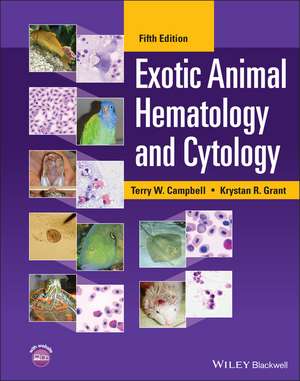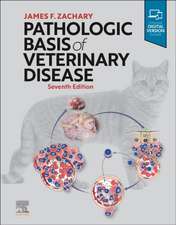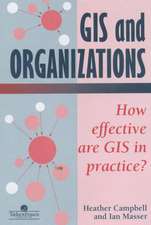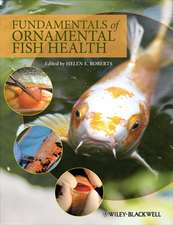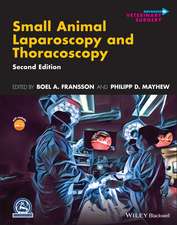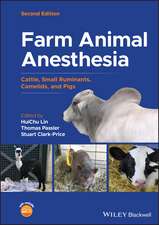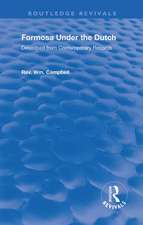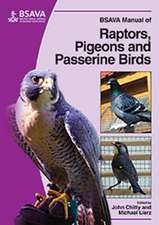Exotic Animal Hematology and Cytology
Autor Campbellen Limba Engleză Hardback – 9 mar 2022
Organized by animal class to make it easier to quickly find critical information, the authors have included 45 new case studies to highlight the application of the content in a real-world setting. All major exotic animal groups are covered, including mammals, birds, reptiles, amphibians, and fish.
Clinicians seeking a decision-making aid for patient workup, treatment, and prognosis will find what they need in Exotic Animal Hematology and Cytology. The book also includes:
- Thorough cellular descriptions unique to mammalian, avian, herptile, and fish species, with extensive discussions of blood and bone marrow sample collection and hematologic techniques for each group
- Comprehensive evaluation of the peripheral blood specific to mammals, birds, herptiles, and fish, as well as the evaluation of bone marrow
- Practical discussions of hematology case studies with applications to common real-world clinical problems
- Color atlas of hemic cells of select species for quick and easy reference
- Extensive examinations of cytodiagnosis and exploration of unique features within mammals, birds, herptiles, and fish, as well as cytology case studies and wet-mount cases in fish
- Access to video clips and additional case reports on a companion website
Preț: 1287.31 lei
Preț vechi: 1355.07 lei
-5% Nou
246.39€ • 256.26$ • 206.48£
Carte disponibilă
Livrare economică 21 februarie-07 martie
Livrare express 06-12 februarie pentru 97.52 lei
Specificații
ISBN-10: 1119660238
Pagini: 720
Dimensiuni: 219 x 284 x 42 mm
Greutate: 1.98 kg
Ediția:5th Edition
Editura: Wiley
Locul publicării:Hoboken, United States
Descriere
The newly revised Fifth Edition of Exotic Animal Hematology and Cytology delivers a fully updated new edition of the most complete reference to hematology and cytology in exotic animals. The book features high-quality images and step-by-step descriptions of practical techniques.
Organized by animal class to make it easier to quickly find critical information, the authors have included 45 new case studies to highlight the application of the content in a real-world setting. All major exotic animal groups are covered, including mammals, birds, reptiles, amphibians, and fish.
Clinicians seeking a decision-making aid for patient workup, treatment, and prognosis will find what they need in Exotic Animal Hematology and Cytology. The book also includes:
- Thorough cellular descriptions unique to mammalian, avian, herptile, and fish species, with extensive discussions of blood and bone marrow sample collection and hematologic techniques for each group
- Comprehensive evaluation of the peripheral blood specific to mammals, birds, herptiles, and fish, as well as the evaluation of bone marrow
- Practical discussions of hematology case studies with applications to common real-world clinical problems
- Color atlas of hemic cells of select species for quick and easy reference
- Extensive examinations of cytodiagnosis and exploration of unique features within mammals, birds, herptiles, and fish, as well as cytology case studies and wet-mount cases in fish
- Access to video clips and additional case reports on a companion website
Exotic Animal Hematology and Cytology is an essential reference for veterinary clinical pathologists, anatomic pathologists, clinicians, and technicians, as well as for veterinary students taking courses involving exotic hematology and cytology.
Cuprins
Preface xi Acknowledgments xii About the Companion Website xiv Scientific Names xv Section I Mammal 1 1. Blood and Bone Marrow Sample Collection and Preparation in Small Mammals 3 Blood Sample Collection 3 Bone Marrow Collection 15 References 17 2. Hematologic Techniques for Quantitative Assessment in Mammals 19 Erythrocyte and Plasma Parameters 19 Leukocyte Parameters 21 Platelet Parameters 21 References 21 3. Evaluation and Interpretation of the Peripheral Blood of Mammals 23 Mammalian Erythrocytes 23 Erythrocyte Response to Disease 28 Mammalian Leukocytes 32 Leukocyte Response to Disease 34 Platelets of Mammals 40 Hemogram Evaluation of Specific Species 42 References 55 4. Evaluation of Mammalian Bone Marrow 59 Mammalian Hematopoiesis 59 Mammalian Bone Marrow Responses in Disease 66 Bone Marrow Evaluation 67 References 67 5. Mammalian Hematology and Clinical Chemistry: Clinical Case Presentations 69 Case 1: Chinchilla with Dental Disease 69 Case 2: Guinea Pig with Gastric Stasis 71 Case 3: Hedgehog with Anorexia 73 Case 4: Ferret with Lethargy, Inappetence, and Labored Breathing 75 Case 5: Ferret with Lethargy and Weakness 79 References 82 6. Sample Collection for Mammalian Cytodiagnosis 83 Cytology Sampling and Evaluation Techniques 83 Sample Locations 83 Preparation for Cytologic Examination 88 Sample Collection Techniques 89 Sample Preparation and Evaluation 94 References 97 7. Mammalian Cytodiagnosis 99 Normal Mammalian Cytology 99 Inflammation 110 Hyperplasia/Benign Neoplasia 124 Malignant Neoplasia 129 Effusions 153 Infectious Agents 160 References 168 8. Mammalian Cytology: Clinical Case Presentations 175 Case 1: Hedgehog with Swelling under the Right Forelimb 175 Case 2: Dumbo Rat with a Mass on Its Face 175 Case 3: Hedgehog with a vaginal mass 178 Case 4: Sugar Glider with a Mass in the Left Axilla 179 Case 5: Ferret with an Abdominal Mass 181 References 184 Section II Avian 185 9. Blood and Bone Marrow Sample Collection and Preparation in Birds 187 Blood Sample Collection 187 Blood Sample Handling and Preparation 192 Bone Marrow Collection 195 Preparation of the Bone Marrow Sample 197 References 199 10. Hematologic Techniques for Quantitative Assessment in Birds 200 Erythrocyte and Plasma Parameters 200 Leukocyte Parameters 204 Thrombocyte Parameters 207 Quantitative Evaluation of Bone Marrow Aspirates 207 References 207 11. Evaluation and Interpretation of Peripheral Blood of Birds 209 Avian Erythrocytes 209 Factors Affecting the Avian Erythrogram 214 Erythrocyte Response to Disease 216 Avian Leukocytes 220 Normal Variation to the Leukogram of Birds 228 Leukocyte Response to Disease 228 Avian Thrombocytes 235 Avian Blood Parasites 237 Bacteremia 244 References 244 12. Evaluation of Avian Bone Marrow 253 Avian Hematopoiesis 253 Avian Hematopoietic Tissue other than Bone Marrow 259 References 260 13. Avian Hematology and Clinical Chemistry: Clinical Case Presentations 262 Case 1: Cockatoo with Lethargy and Anorexia 262 Case 2: Swainson's Hawk with Head Trauma 265 Case 3: Pionus Parrot with Weight Loss, Exercise Intolerance, and Sneezing 269 Case 4: Conure with Lethargy and Anorexia 273 Case 5: Hawk with Dehydration and Emaciation 274 References 278 14. Sample Collection for Avian Cytodiagnosis 279 References 286 15. Avian Cytodiagnosis 288 Normal Avian Cytology 288 Inflammation 298 Hyperplasia/Benign neoplasia 315 Malignant Neoplasia 319 Effusions 332 Infectious Agents 338 References 354 16. Avian Cytology and Clinical Chemistry: Clinical Case Presentations 365 Case 1: Lethargic Parrot 365 Case 2: Macaw with Periorbital Swelling 366 Case 3: Eagle with Swollen Right Foot 369 Case 4: Owl with Oral Lesions 370 Case 5: Hawk with Skin Lesions 371 References 374 Section III Herptile 375 17. Blood and Bone Marrow Sample Collection and Preparation in Reptiles and Amphibians 377 Blood Sample Collection 377 Blood Sample Handling and Preparation 387 Bone Marrow Collection 388 References 389 18. Hematologic Techniques for Quantitative Assessment in Reptiles and Amphibians 391 Erythrocyte and Plasma Parameters 391 Leukocyte Parameters 394 Thrombocyte Parameters 397 References 397 19. Evaluation and Interpretation of the Peripheral Blood and Bone Marrow of Reptiles 399 The Interpretation of the Reptile Hemogram 399 Reptile Erythrocytes 399 Factors Affecting the Reptile Erythrogram 401 Erythrocyte Response to Disease 404 Reptile Leukocytes 405 Normal Variation to the Leukogram of Reptiles 413 Leukocyte Response to Disease 414 Reptile Thrombocytes 419 Reptile Blood Parasites 420 Reptile Hematopoiesis and Bone Marrow Evaluation 425 References 428 20. Evaluation and Interpretation of the Peripheral Blood and Bone Marrow of Amphibians 433 Amphibian Erythrocytes 433 Amphibian Leukocytes 435 Amphibian Thrombocytes 439 Amphibian Blood Parasites 440 Amphibian Hematopoiesis and Bone Marrow Evaluation 440 References 441 21. Herptile Hematology and Clinical Chemistry: Clinical Case Presentations 443 Case 1: Snake with Nasal Discharge and Mites 443 Case 2: Snake with Neurologic Behavior and Skin Nodules 445 Case 3: Comparison of two chelonian respiratory cases 448 Case 4: Case Series of Chelonian Dystocia and Follicular Stasis 454 Case 5: Lizard with Limb Lameness, Lethargy, and Anorexia 463 References 465 22. Sample Collection for Herptile Cytodiagnosis 466 Sample Locations 466 References 469 23. Herptile Cytodiagnosis 470 Normal Cytology 470 Inflammation 475 Hyperplasia/Benign Neoplasia 488 Malignant Neoplasia 489 Effusions 498 Infectious Agents 500 References 511 24. Herptile Cytology and Clinical Chemistry: Clinical Case Presentations 518 Case 1: Snake with a Bulging Right Eye 518 Case 2: Lizard with Lethargy and Neurologic Disorder 521 Case 3: Lizard with Skin Lesion 524 Case 4: Thin Snake with Swollen Mouth 524 Case 5: Snake with Diarrhea 527 References 528 Section IV Fish 529 25. Blood Sample Collection and Preparation in Fish 531 Blood Sample Collection 531 Blood Sampling Handling and Preparation 537 References 539 26. Hematologic Techniques for Quantitative Assessment in Fish 541 Erythrocyte and Plasma Parameters 541 Leukocyte Parameters 545 Thrombocyte Parameters 546 Whole Blood Preservatives 547 References 547 27. Evaluation and Interpretation of the Peripheral Blood of Fish 549 Fish Erythrocytes 549 Factors Affecting the Piscine Erythrogram 552 Erythrocyte Response to Disease 554 Fish Leukocytes 556 Variations in the Leukogram of Fish 565 Fish Thrombocytes and Hemostasis 567 Fish Blood Parasites 569 Viral Inclusions 570 References 571 28. Piscine Hematopoiesis 575 References 576 29. Piscine Hematology and Clinical Chemistry: Clinical Case Presentations 578 Case 1: Nurse Shark with Excessive Gilling 578 Case 2: Reticulated Stingray with Bite Wounds 581 Case 3: Southern Stingray with Anorexia 582 Case 4: Knifefish with Tail Wound 586 Case 5: Toadfish Found Abnormally Floating 586 References 591 30. Sample Collection for Wet Mounts and Cytodiagnosis in Fish 593 Sampling Techniques for Wet Mounts 593 Sampling Techniques for Cytodiagnosis 596 References 599 31. Wet-Mount Microscopy in Fish 600 Sample Evaluation 600 Nonparasitic Pathogens 603 Cutaneous Fish Parasites 605 Nonpathogenic Organisms 618 References 619 32. Wet-Mount Microscopy in Fish: Clinical Case Presentations 622 Case 1: Tiger Barb with Skin and Behavior Changes 622 Case 2: Newly Arrived Goldfish 622 Case 3: Cichlid with a Missing Eye 624 Case 4: Catfish with Rapid Breathing and Lethargy 625 Case 5: Damselfish with Skin Lesions and Behavior Changes 625 33. Piscine Cytodiagnosis 627 Skin 627 Calcinosis Circumscripta 630 Fecal Cytology 630 Mycobacteriosis 630 Saprolegniasis 631 Thyroid 631 Hepatic Lipidosis 631 Neoplasia 631 Effusions 635 Parasites 636 Sample Contamination 636 References 637 34. Piscine Cytology and Clinical Chemistry: Clinical Case Presentations 639 Case 1: Shark with Cutaneous Nodules 639 Case 2: Trout with a Mass on Mandible 640 Case 3: Seahorse with Possible Gas Bubble Disease 643 Case 4: Carp with Swollen Operculum 644 Case 5: Perch with Mass on Left Gill 645 References 647 Appendices 648 A. Stains and Solutions Used in Hematology and Cytology 648 Acid-Fast Stain 648 Gram's Stain 648 Macchiavello's Stain 649 Modified Giménez Stain 649 New Methylene Blue Stain 650 Standard Natt and Herrick's Solution and Stain 650 Elasmobranch-Modified Natt and Herrick's Solution and Stain 651 Quick or Stat Stains 651 Sudan III and Sudan IV Stains 652 Wright-Giemsa Stain 652 B. Hematologic Values 653 C. Plate Captions 663 Mammal Plates 663 Avian Plates 665 Herptile Plates 668 Piscine Plates 676 D. Common Artifacts Found in Blood Film and Cytologic Samples 681 Artifacts Associated with Contamination of the Sample 681 Artifacts Associated with Poor Sample Preparation 683 Index 686
Notă biografică
The authors Terry W. Campbell, DVM, PhD, is an Associate Professor Emeritus of Zoological Medicine at the College of Veterinary Medicine and Biomedical Sciences at Colorado State University in Fort Collins, CO, USA, and was the Former Head Veterinarian at the Downtown Aquarium in Denver, CO, USA. Krystan R. Grant, DVM, PhD, CertAqV, is the Director of Pet Health at the PetSmart Home Office in Phoenix, AZ, USA.
